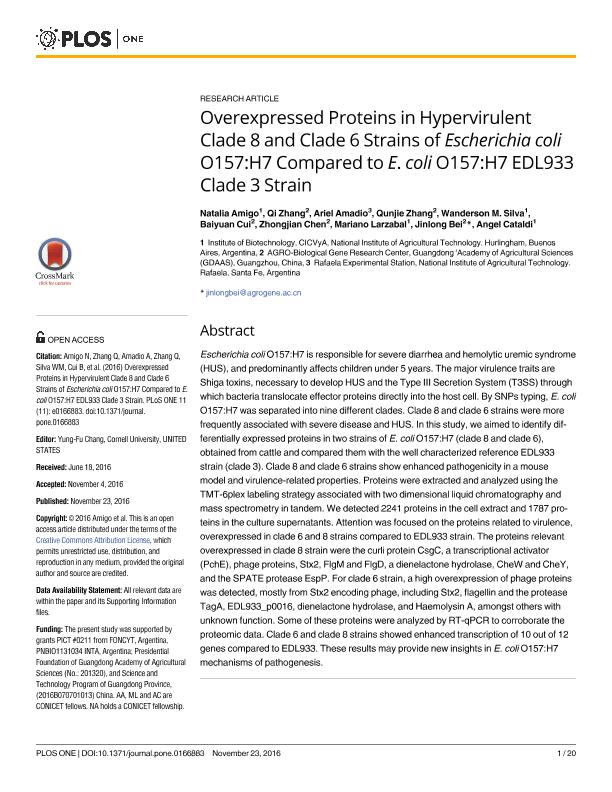Mostrar el registro sencillo del ítem
dc.contributor.author
Amigo, Natalia

dc.contributor.author
Zhang, Qi
dc.contributor.author
Amadio, Ariel Fernando

dc.contributor.author
Zhang, Qunjie
dc.contributor.author
Marques Da Silva, Wanderson

dc.contributor.author
Cui, Baiyuan
dc.contributor.author
Chen, Zhongjian
dc.contributor.author
Larzabal, Mariano

dc.contributor.author
Bei, Jinlong
dc.contributor.author
Cataldi, Ángel Adrián

dc.date.available
2020-08-07T15:40:17Z
dc.date.issued
2016-11
dc.identifier.citation
Amigo, Natalia; Zhang, Qi; Amadio, Ariel Fernando; Zhang, Qunjie; Marques Da Silva, Wanderson; et al.; Overexpressed Proteins in Hypervirulent Clade 8 and Clade 6 Strains of Escherichia coli O157:H7 Compared to E. coli O157:H7 EDL933 Clade 3 Strain; Public Library of Science; Plos One; 11-2016; 1-20
dc.identifier.issn
1932-6203
dc.identifier.uri
http://hdl.handle.net/11336/111164
dc.description.abstract
Escherichia coli O157:H7 is responsible for severe diarrhea and hemolytic uremic syndrome (HUS), and predominantly affects children under 5 years. The major virulence traits are Shiga toxins, necessary to develop HUS and the Type III Secretion System (T3SS) through which bacteria translocate effector proteins directly into the host cell. By SNPs typing, E. coli O157:H7 was separated into nine different clades. Clade 8 and clade 6 strains were more frequently associated with severe disease and HUS. In this study, we aimed to identify differentially expressed proteins in two strains of E. coli O157:H7 (clade 8 and clade 6), obtained from cattle and compared them with the well characterized reference EDL933 strain (clade 3). Clade 8 and clade 6 strains show enhanced pathogenicity in a mouse model and virulence-related properties. Proteins were extracted and analyzed using the TMT-6plex labeling strategy associated with two dimensional liquid chromatography and mass spectrometry in tandem. We detected 2241 proteins in the cell extract and 1787 proteins in the culture supernatants. Attention was focused on the proteins related to virulence, overexpressed in clade 6 and 8 strains compared to EDL933 strain. The proteins relevant overexpressed in clade 8 strain were the curli protein CsgC, a transcriptional activator (PchE), phage proteins, Stx2, FlgM and FlgD, a dienelactone hydrolase, CheW and CheY, and the SPATE protease EspP. For clade 6 strain, a high overexpression of phage proteins was detected, mostly from Stx2 encoding phage, including Stx2, flagellin and the protease TagA, EDL933_p0016, dienelactone hydrolase, and Haemolysin A, amongst others with unknown function. Some of these proteins were analyzed by RT-qPCR to corroborate the proteomic data. Clade 6 and clade 8 strains showed enhanced transcription of 10 out of 12 genes compared to EDL933. These results may provide new insights in E. coli O157:H7 mechanisms of pathogenesis.
dc.format
application/pdf
dc.language.iso
eng
dc.publisher
Public Library of Science

dc.rights
info:eu-repo/semantics/openAccess
dc.rights.uri
https://creativecommons.org/licenses/by-nc-sa/2.5/ar/
dc.subject
ESCHERICHIA COLI O157:H7
dc.subject
OVEREXPRESSED PROTEINS
dc.subject
PROTEOMICS
dc.subject
VIRULENCE FACTORS
dc.subject.classification
Biología Celular, Microbiología

dc.subject.classification
Ciencias Biológicas

dc.subject.classification
CIENCIAS NATURALES Y EXACTAS

dc.title
Overexpressed Proteins in Hypervirulent Clade 8 and Clade 6 Strains of Escherichia coli O157:H7 Compared to E. coli O157:H7 EDL933 Clade 3 Strain
dc.type
info:eu-repo/semantics/article
dc.type
info:ar-repo/semantics/artículo
dc.type
info:eu-repo/semantics/publishedVersion
dc.date.updated
2020-08-05T16:38:25Z
dc.journal.pagination
1-20
dc.journal.pais
Estados Unidos

dc.journal.ciudad
San Francisco
dc.description.fil
Fil: Amigo, Natalia. Instituto Nacional de Tecnología Agropecuaria. Centro de Investigación en Ciencias Veterinarias y Agronómicas; Argentina. Consejo Nacional de Investigaciones Científicas y Técnicas; Argentina
dc.description.fil
Fil: Zhang, Qi. Guangdong Academy Of Agricultural Sciences; China
dc.description.fil
Fil: Amadio, Ariel Fernando. Consejo Nacional de Investigaciones Científicas y Técnicas; Argentina. Instituto Nacional de Tecnología Agropecuaria. Centro Regional Santa Fe. Estación Experimental Agropecuaria Rafaela; Argentina
dc.description.fil
Fil: Zhang, Qunjie. Guangdong Academy Of Agricultural Sciences; China
dc.description.fil
Fil: Marques Da Silva, Wanderson. Consejo Nacional de Investigaciones Científicas y Técnicas; Argentina. Instituto Nacional de Tecnología Agropecuaria. Centro de Investigación en Ciencias Veterinarias y Agronómicas; Argentina
dc.description.fil
Fil: Cui, Baiyuan. Guangdong Academy Of Agricultural Sciences; China
dc.description.fil
Fil: Chen, Zhongjian. Guangdong Academy Of Agricultural Sciences; China
dc.description.fil
Fil: Larzabal, Mariano. Instituto Nacional de Tecnología Agropecuaria. Centro de Investigación en Ciencias Veterinarias y Agronómicas; Argentina. Consejo Nacional de Investigaciones Científicas y Técnicas; Argentina
dc.description.fil
Fil: Bei, Jinlong. Guangdong Academy Of Agricultural Sciences; China
dc.description.fil
Fil: Cataldi, Ángel Adrián. Consejo Nacional de Investigaciones Científicas y Técnicas; Argentina. Instituto Nacional de Tecnología Agropecuaria. Centro de Investigación en Ciencias Veterinarias y Agronómicas; Argentina
dc.journal.title
Plos One

dc.relation.alternativeid
info:eu-repo/semantics/altIdentifier/doi/http://dx.doi.org/10.1371/journal.pone.0166883
dc.relation.alternativeid
info:eu-repo/semantics/altIdentifier/url/https://journals.plos.org/plosone/article?id=10.1371/journal.pone.0166883
Archivos asociados
